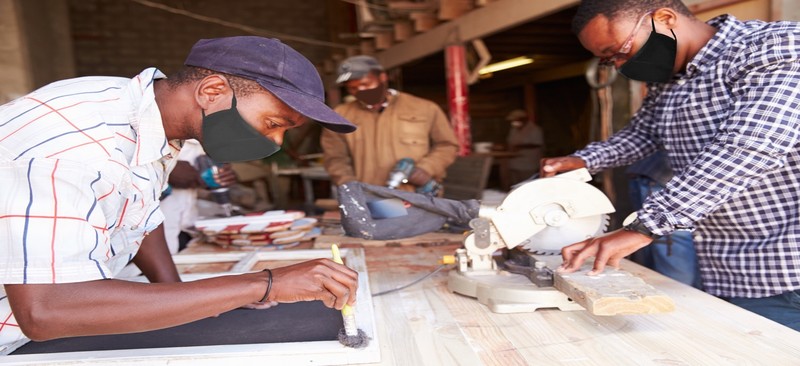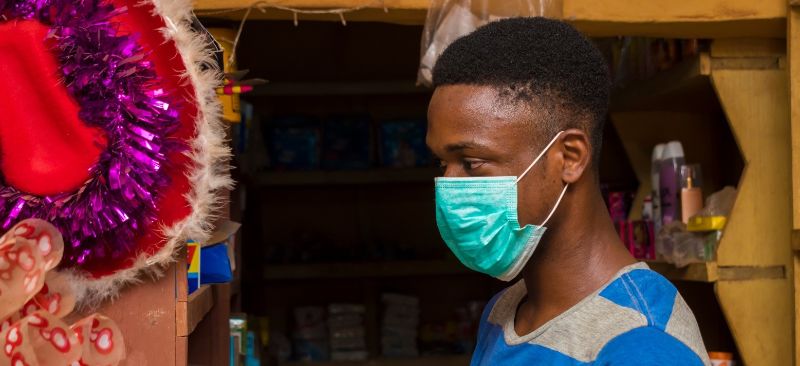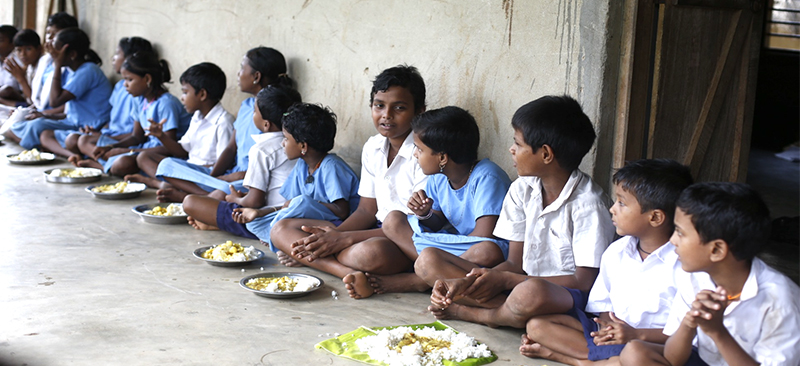Across the country, MSMEs were showing signs of recovery once the markets reopened. Yet they are nowhere near their pre-pandemic figures. Entrepreneurs are increasingly concerned about the increased cost of supplies and transportation, and struggle to secure loans. Customers too have limited their spending to essential goods. Read on as we examine the damage done and look at ways in which the government and other private agencies can help the sector recover. Key findings from the third round of a dipstick research funded jointly by MSC and SCBF feed into this report.
Corner shop diaries: A multi-country year-long research project on micro-businesses
The Corner Shop Diaries project: How small businesses in developing countries coped with the pandemic, helped the neighborhood to survive the lockdown, and embarked on the challenging journey to recovery
The past ten months have been a rollercoaster for Ali, owner of a corner shop from Wonosobo Regency in the Central Java province of Indonesia. As the pandemic swept through his community, Ali did not know if his business would survive. He was unsure if he could open his corner shop, where he would be able to secure supplies from, and even whether he dare accept payments in banknotes—alleged to spread the deadly virus.
In time, the cost of supplies rose and the wholesaler refused to deliver them to his shop. Ali persevered, driven by the need to protect his business and ensure that his community could get the basics for survival. He used social media to tell people what he had in stock and thought about accepting digital payment, but chose not to as there was little demand for it among his regular customers.
As the pandemic recedes and the promises of vaccines offer light at the end of what has been a torturously long and dark tunnel, Ali is rebuilding and diversifying his business. “At times I thought I did not have enough liquidity to survive but I have emerged stronger. I have even learnt how to market using WhatsApp and Facebook”, he reveals with a hint of pride.
Restricted mobility, a constant fear of exposure to the virus, loss of loved ones, and loss of income have characterized the year 2020 (and it continues in 2021 with reduced scale). The scale of the COVID-19 pandemic has been unprecedented, at least in the past 100 years. Till mid-January 2021, the novel coronavirus has claimed close to 2 million lives across the globe and crippled the economy of numerous countries, mostly owing to measures like lockdowns that the governments were forced to take to control the health emergency.
As the pandemic started to unfold, MSC identified how we could help inform the response to this unprecedented global emergency and reduce its damaging effects. After rounds of internal discussions and brainstorming, we started a two-pronged approach.
- Information to protect frontline workers and their clients: We developed communication material to inform MFI staff, CICO agents, and community members (MFI clients, SHG members) about the pandemic and safety measures they can adopt. These are now being used by organizations and have reached more than 26 million clients.
- Research to inform policy: We also launched a series of research initiatives to generate insights on the impact of the pandemic among various segments of the society (low- and moderate-income people, micro, small and medium enterprises, women, farmers, fintechs, etc.). Besides, we provided clear, actionable recommendations for policy interventions to respond to the pandemic and mitigate its damaging effects.
To fight an enemy as dangerous as the COVID-19 pandemic, we needed allies. And we found a natural ally with L-IFT. Like MSC, L-IFT sought opportunities to help the global community respond. They started by extending their Corner Shop Diaries project in Africa. The project tracked corner shops, small retail businesses, in neighborhoods where these shops were the sole source of essentials during the lockdown, using the Financial Diaries methodology. Recognizing the potential of this approach, MSC partnered with L-IFT to bring the project to Asia.
Since April, 2020, 78 corner shops in Senegal, Zimbabwe, Nigeria, and Uganda have reported to L-IFT on their financial transactions, how they are doing, and whether they can provide the basics to their customers. In July, 2020, five corner shops from Stuart Rutherford’s pioneering Hrishipara Financial Diaries joined the project. And from October, 2020, MSC started to track the progress of 25 corner shops each from India and Indonesia. L-IFT started tracking 18 corner shops in Mali from third week of January, 2021.
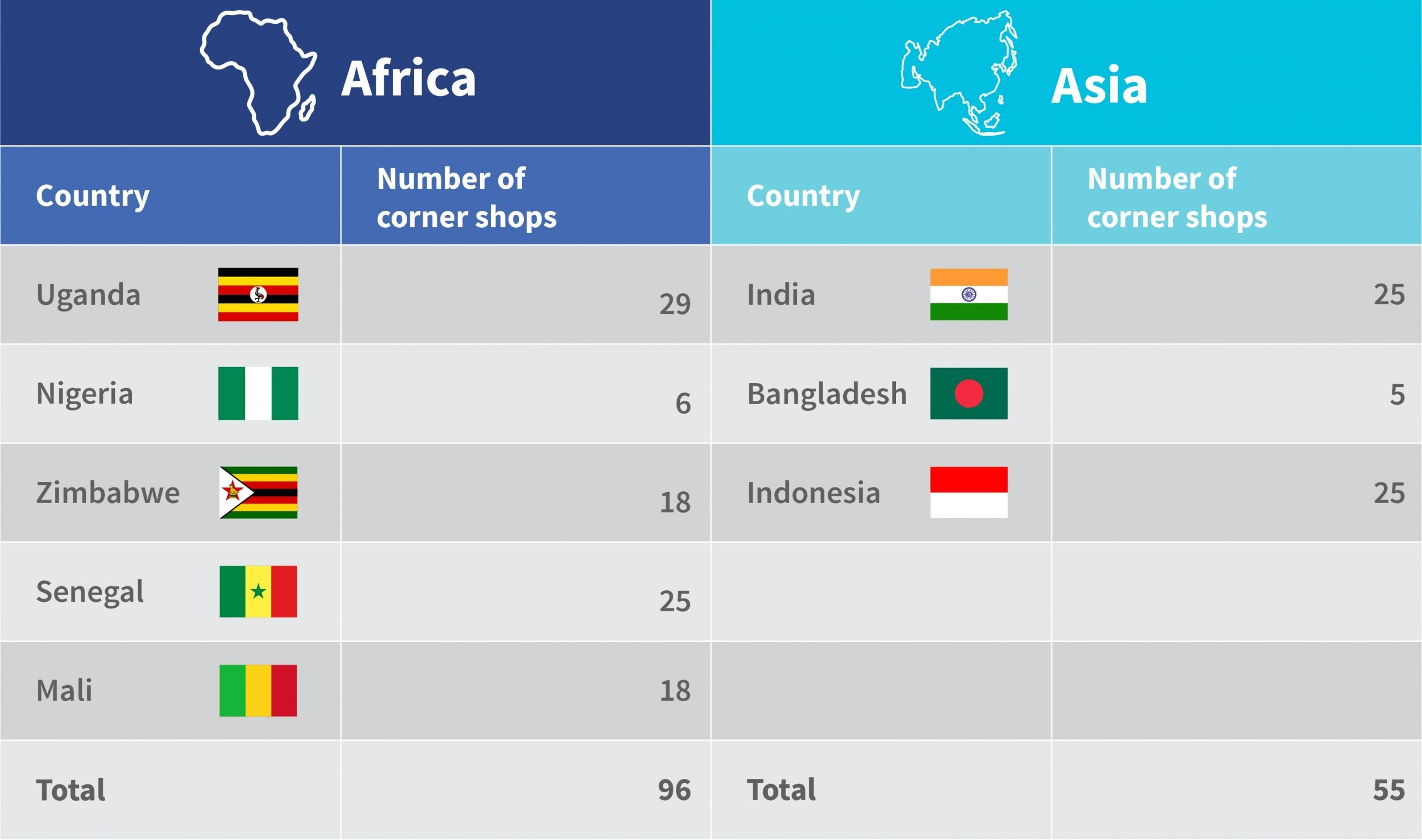
What was the rationale behind starting this research project? We are worried that all the poorest countries would be hurt disproportionately—not only by the disease but also by the lockdowns. Jean Drèze’s work on famines shows that most famines are the result of failing markets, faltering supply chains, and price shocks. We were concerned that these might happen as a result of the pandemic. We, therefore, wanted to track corner shops in different countries to monitor if food and other basics were still available, whether people could still afford them, and whether shops were surviving and could play their role of serving their communities and neighborhoods.
Initially, the research was seen as a way to identify, provide data, and raise the alarm for any specific locations where the situation was critical. Once the lockdowns were eased, the pandemic started to dissipate, and the economies started to revive, this research became a way to chronicle the journeys of the corner shops towards recovery, and to identify factors critical to their success.

The Corner Shop Diaries research sheds light on a variety of aspects (see Box 1) related to the effects of the pandemic and subsequent lockdowns on micro businesses and the people they serve. Even more importantly, if we can continue this data collection, we can learn about:
- How soon corner shops and their clients can reach pre-COVID economic levels;
- The challenges they face while doing so;
- What financial resources they can access;
- The barriers they face on their path to recovery;
- The impact of national and regional policies on their businesses; and
- Opportunities for governments and other agencies to support them.
Furthermore, we can examine in detail:
- How these corner shops market their goods and accept payment;
- The role (if any) that digitization might play, as well as the barriers and enabling factors for digital adoption; and
- How their path to digital acceptance might be accelerated.
We have documented our lessons from this research project in different countries through a series of blogs that we will publish on the project website as well as on the MSC website. Stay tuned for a more nuanced understanding of the struggle of small businesses during the pandemic and policy recommendations that can (and could have) help them to cope and recover.
For more details about the Corner Shop Diaries project, please write to Rahul Chatterjee <rahul.chatterjee@microsave.net>.
Impact of the COVID-19 pandemic on farmers- Kenya report (round 3)
Agriculture is the largest employer in the world and could not escape the destructive effects of the COVID-19 pandemic. The disease and the resultant restrictions have had a severe impact on agricultural activities and ultimately on farmers. People in the agricultural communities have continued to struggle with low revenues and profits that stem from the fall in demand and fluctuations in the price of the products. The increase in the cost of inputs and high operational costs for transport has proven to be a challenge.
Many farmers lack enough cash to pay wages to farm laborers and have consequently laid off several staff members, which has increased the vulnerability of the daily wage laborers. The sector needs appropriate responses at all levels to support the farmers in the aftermath of the crisis. This spurred MSC’s research to assess the economic impact of the COVID-19 pandemic on farmers in Kenya to understand the extent of impact and identify areas that require support in the short, medium, and long term. The report presents the comparison between the status of farmers in September and in December, 2020.
Impact of the COVID-19 pandemic on CICO agents- Kenya report (round 3)
Since the economy has reopened, most agents have started to see rising footfall, number of transactions, and even commissions earned. However, their business is yet to return to pre-COVID levels. Although CICO agents are the key enablers of social benefits transfers, they have not received any relief or support measures similar to those offered to other enterprises during the pandemic. Our report takes a deeper look at the situation and provides recommendations to the government and financial institutions on initiatives that will boost the transactions and income level of the agents.
NFHS 5 calls for urgent action on child nutrition in India
The percentage of children who are stunted, wasted, underweight, anemic, and obese is on the rise across India. Despite impressive progress in areas, such as water and sanitation—immunization and maternal health indicators of child health alongside nutrition remain a matter of grave concern. UNICEF predicts a further increase in malnutrition by at least 10% in the country, as a result of the COVID-19 crisis.
The Ministry of Health and Family Welfare, Government of India has recently released a report on findings from the first round of the Fifth National Family Health Survey (NFHS 5). The survey covers 17 states and five union territories, which comprise 54% of India’s population, and informs policy on household-level health and nutrition indicators. Since the NFHS is an outcome-level survey, conclusions or attributions on inputs and policies that might have contributed to these outcomes are difficult to draw.
The NFHS has 42 indicators related to child health and nutrition. The trends in neonatal and infant mortality rates from 2015 to 2019 suggest that India has managed to reduce child mortality. Yet the major public health indicators for child health have only improved marginally or not at all, while nutrition-related indicators have worsened in most states. These include stunting (13 out of 22 states and union territories saw an increase), wasting (12 states and union territories saw an increase), underweight (16 states and union territories saw an increase), anemia (16 states and union territories saw an increase), and obesity (all states and union territories except Goa saw an increase).
NFHS-5 child nutrition story
Stunting: The level of stunting, or lower-than-expected height for age, has either deteriorated or improved only marginally in most states and union territories, as compared to NFHS-4 (2015-16). Out of the states surveyed, the levels of stunting worsened in 11 states while others recorded a marginal improvement. The rates of stunting went up significantly in the states of Goa, Kerala, Telangana, and Himachal Pradesh. Tripura emerged as the worst-performing state on the indicator, with a rise from 24.3% to 32.3% in the last four years. Bihar, which had the highest levels of stunting in NFHS-4, saw a marginal decline from 48.3% to 42.9%.
The National Family Health Survey (NFHS) survey is a large-scale nationwide survey of households. The ministry has designated the International Institute of Population Sciences as the nodal agency. Fifth in the series, the factsheet released for states and union territories provides aggregated data on 131 parameters. NFHS-3 was conducted in 2005-06 and NFHS-4 in 2015-16.
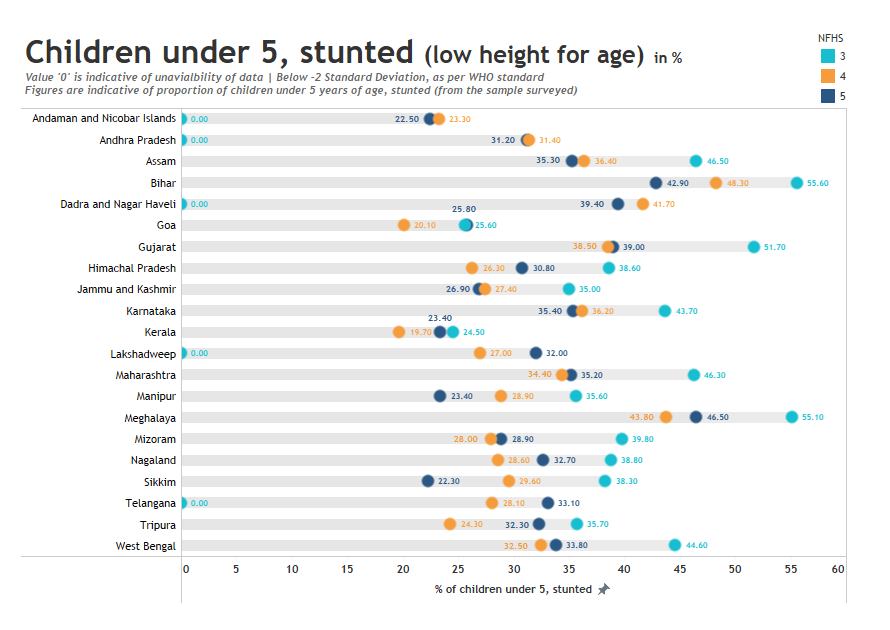
Wasting: The levels of wasting, or lower-than-expected weight for height, saw a similar trend of reversal or stagnation in most states. Of the 21 states and union territories, 10 have reversed on the parameter and the figures are closer to the levels in NFHS-3 (2005-06). Nagaland and the union territories of Jammu and Kashmir increased by six percentage basis points. With a drop from 26.1% to 19.5%, Karnataka emerged as the best-performing state. The states of Meghalaya and Goa also improved as compared to the previous survey.
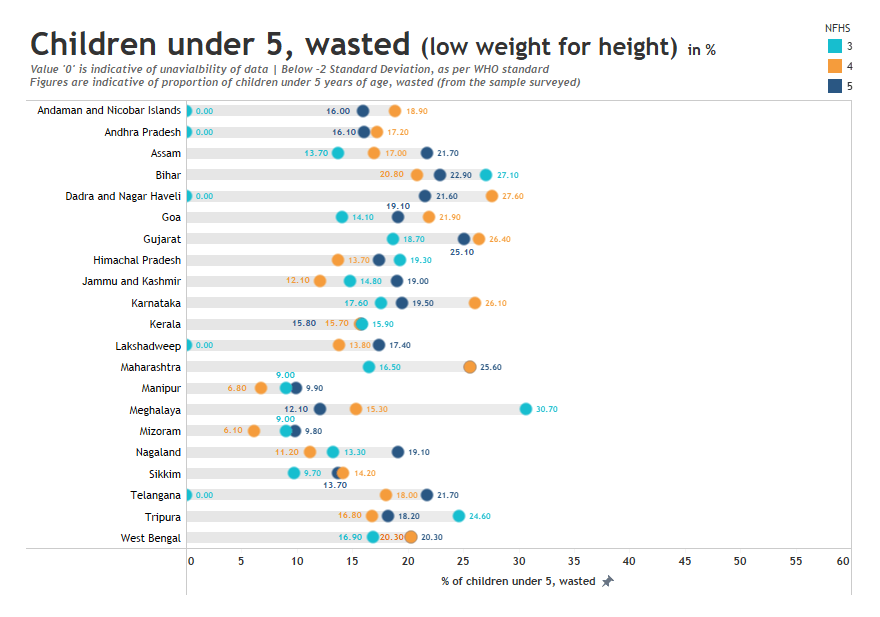
Underweight: Another indicator used to gauge the status of child nutrition is the percentage of underweight children aged five or less. This indicator also showed alarming trends similar to other nutrition parameters. The population of underweight children increased in 11 states and all five union territories. Bihar, Gujarat, and a few northeastern (NE) states saw a marginal to low decline in the levels. However, more affluent states like Kerala and Telangana saw a rise in the proportion of underweight children by almost three percentage basis points. The levels went up from 16.1% to 19.7% in Kerala and from 28.5% to 31.8% in Telangana.
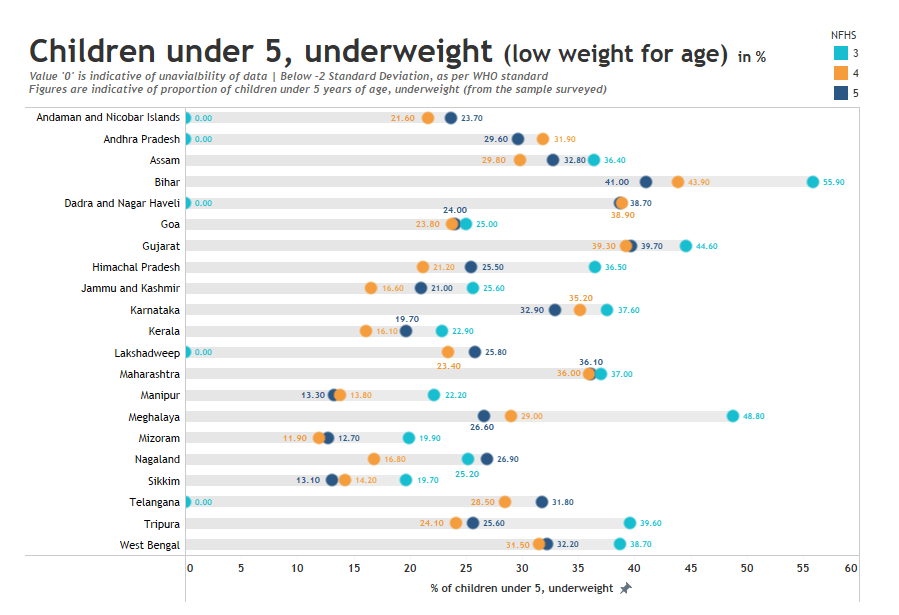
Overweight: Children aged under five are considered overweight if their weight-for-height is two standard deviations above the median of WHO’s Child Growth Standards. Although the proportion in India is within the world average as per WHO, the indicator is under distress. As compared to the previous survey, 16 out of 17 states recorded an increase in the percentage of overweight children in NFHS-5.
With a decrease from 3.7% to 2.8%, Goa was the best-performing state. All other states recorded an increase in the indicator, ranging from 0.1% to 5.8%. The percentage of overweight children more than doubled in Mizoram.
The findings point to a triple burden of malnutrition in India, in terms of stunting, wasting, and child obesity.
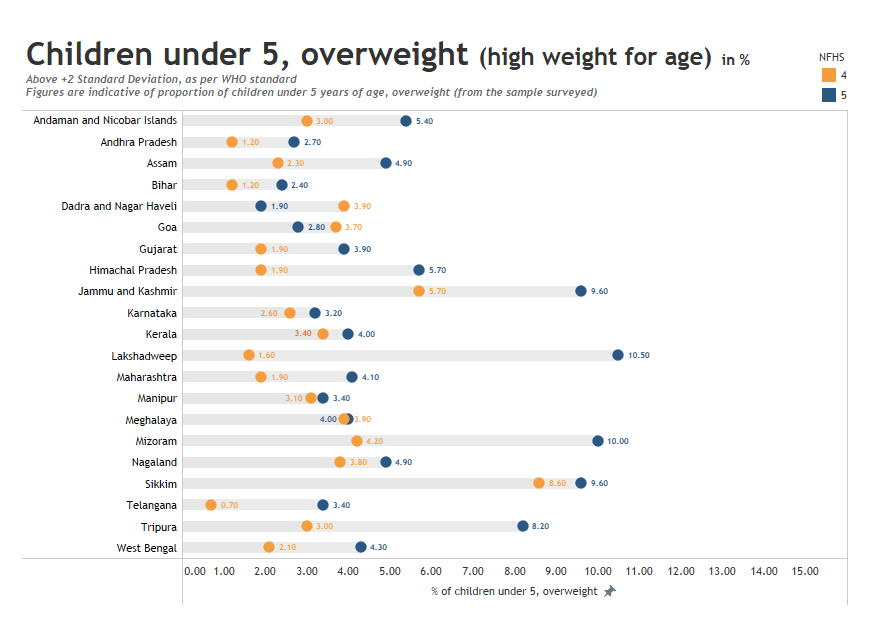
Anemia: The increasing prevalence of anemia among children aged 6-59 months was also worrying. In some states, the prevalence is even higher than that of NFHS-3 (2005-06). For instance, the levels rose from 35.7% to 68.4% in Assam, while Gujarat recorded a 15% increase. Other states also show a major reversal from NFHS 4 levels. The analysis highlights that as compared to NFHS-4, the parameter has worsened in 17 out of the 21 states and union territories, as shown in the graph below.
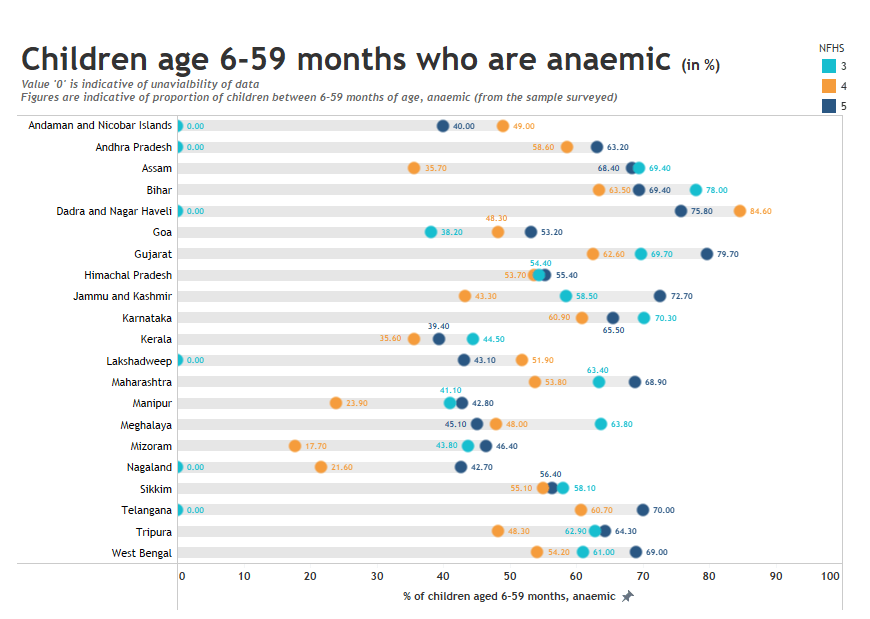
Though phase 2 data from other states will provide more clarity, these results are certainly a cause for concern and require urgent action. The second phase of NFHS-5 may present even more alarming findings since the survey was carried out after the lockdown-related restrictions were relaxed.
Underutilization of allocated resources
The government must also consider the results of the first phase of NFHS-5 in the context of India’s Mid-Day Meal (MDM) initiative. The Accountability Initiative of the Centre for Policy Research reported that only 14 states utilized 100% of the total funds allocated under MDM in 2018-19, which indicates sub-optimal performance on the ground. Another analysis by the Accountability Initiative shows that only 44% of the government-approved amount for Integrated Child Development Services (ICDS) was utilized in 2018-19. Furthermore, the number of children aged six months to six years who receive benefits under the Supplementary Nutrition Programme (SNP) was less than half the estimated number of beneficiaries in 21 states and union territories between 2017 and 2019.
The economic slowdown and stagnation in wages of the poor have translated to lower consumption, as evident from the expenditure survey of NSSO (2017-18). In this context, the results of NFHS-5 will likely reflect the reduced ability of the poor to access quality nutrition and the inadequate contribution to programs, such as ICDS and MDM, which advance better nutrition.
Need for enhanced focus on nutrition due to COVID-19
The COVID-19 pandemic has the makings of a perfect storm for the existing nutrition crisis. According to the India Child Well-being Report 2020 of World Vision India, more than 115 million children in the country no longer have three meals a day and many continue to miss mid-day meals as schools remain closed. This will have long-term adverse effects on the economic prospects of the country due to reduced schooling and cognitive impairments, and the consequent loss in productivity.
New estimates by Derek Headey and colleagues in The Lancet suggest that without timely action, the global prevalence of child wasting could rise by a shocking 14.3%. In the face of a drastic decline in income, the poor would stop consuming the more expensive nutrient-rich foods to preserve their caloric intake. This would exacerbate the undernutrition crisis. For the poorest and the most vulnerable of India, the effects could be particularly detrimental.
Dalberg’s survey of 47,000 poor households highlights the devastating economic impacts during the lockdown imposed to curb the spread of COVID-19. Primary income earners in two-thirds of surveyed households in the LMI segment lost their jobs or wages during the lockdown, and the average family lost more than 60% of their pre-crisis income. The economic distress, coupled with the halt in the mid-day meal initiative, is expected to lead to a dangerous deterioration in dietary quality.
While the ministry is yet to release granular data for all states and union territories, the consistent reversal on several parameters that gauge child nutrition is apparent from the phase 1 data. The overall trends suggest an improvement in many input indicators, such as access to sanitation, use of cleaner fuels, immunization, maternal health check-ups, exclusive breastfeeding, and adequacy of the diet. Other social determinants of health, including indicators of women’s empowerment, have also improved. However, more focused policy analysis, revised policies, and institutional overhaul are needed to identify and address the multidimensional aspects of child malnutrition.
The drop in performance across child nutrition indicators is a wake-up call for India. The country must take proactive measures and scale-up innovations to address malnutrition. Going forward, the government needs to work on certain quick fixes to address the issue of malnutrition. These could include:
- Dietary diversification at the household level, as part of the national nutrition strategy for effective supplementation of micronutrients;
- Launch and scale-up of innovations with a focus on improvement in healthcare and nutrition among children. These would include the promotion of exclusive breastfeeding, food fortification across PDS, ICDS, and MDM, enhanced care, referrals and management of severely undernourished and sick children, effective implementation of Vitamin A supplements to children up to the age of five, and regular deworming;
- Enhanced emphasis on nutrition literacy at the household level;
- Adoption of alternate delivery channels like cash transfer pilots in high-burden districts to encourage dietary diversification.
References;
[1] The National Family Health Survey (NFHS) survey is a large-scale nationwide survey of households. The ministry has designated the International Institute of Population Sciences as the nodal agency. Fifth in the series, the factsheet released for states and union territories provides aggregated data on 131 parameters. NFHS-3 was conducted in 2005-06 and NFHS-4 in 2015-16.
